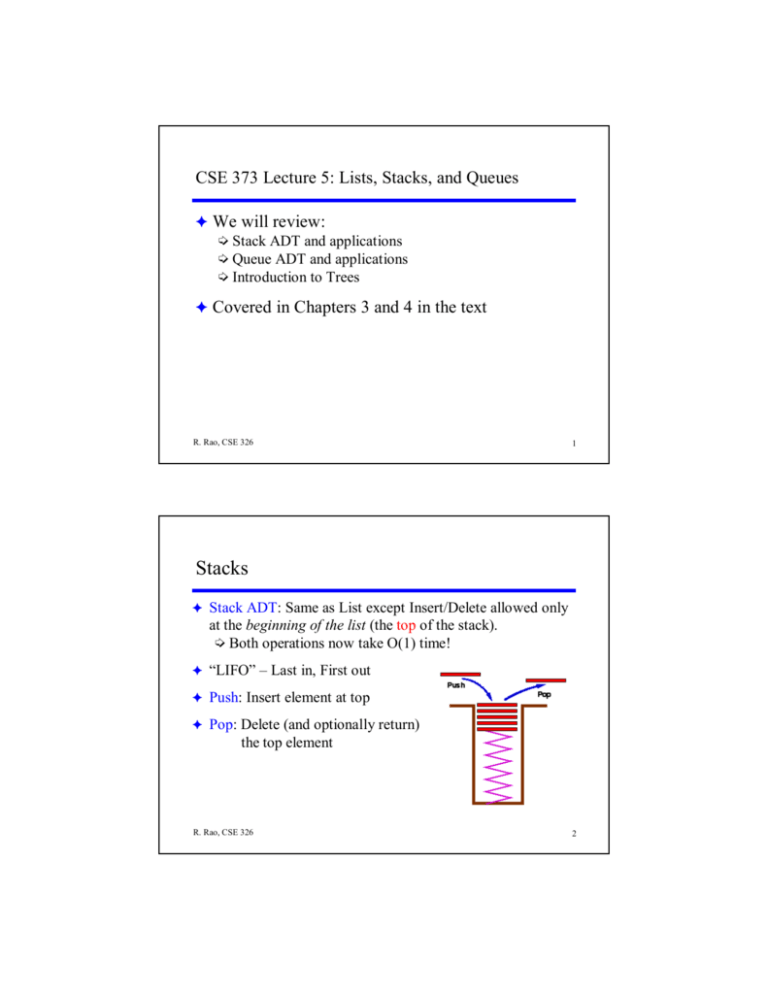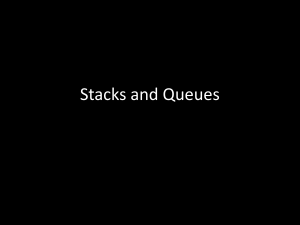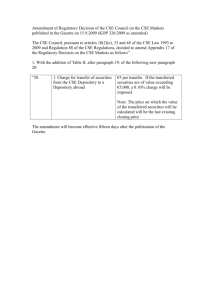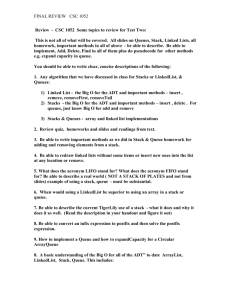Stacks, Queues, and Trees
advertisement

CSE 373 Lecture 5: Lists, Stacks, and Queues
✦ We will review:
➭ Stack ADT and applications
➭ Queue ADT and applications
➭ Introduction to Trees
✦ Covered in Chapters 3 and 4 in the text
R. Rao, CSE 326
1
Stacks
✦ Stack ADT: Same as List except Insert/Delete allowed only
at the beginning of the list (the top of the stack).
➭ Both operations now take O(1) time!
✦ “LIFO” – Last in, First out
✦ Push: Insert element at top
✦ Pop: Delete (and optionally return)
the top element
R. Rao, CSE 326
2
Stack ADT
✦ Operations:
➭
➭
➭
➭
➭
➭
push(Object x)
pop( )
top( )
topAndPop ( )
isEmpty( )
MakeEmpty( )
// Insert item at top of stack
// Remove topmost item from stack
// Return topmost item without altering stack
// Return and remove topmost item from stack
// Return TRUE if stack is empty
// Make stack empty
✦ Implementations:
➭ Linked list with Header, Header’s Next points to top of stack
➭ Array-based: Pre-allocate array; top is Array[TopofStack]
➧ Push x: Increment TopofStack; set Array[TopofStack] = x
✦ Run time for each of these operations?
R. Rao, CSE 326
Stack ADT
3
Go through the Java/C++ code
for these in your text
✦ Operations:
➭
➭
➭
➭
➭
➭
push(Object x)
pop( )
top( )
topAndPop ( )
isEmpty( )
MakeEmpty( )
// Insert item at top of stack
// Remove topmost item from stack
// Return topmost item without altering stack
// Return and remove topmost item from stack
// Return TRUE if stack is empty
// Make stack empty
✦ Run time: All operations are O(1) (except MakeEmpty for
Linked List implementation which takes Θ(N))
R. Rao, CSE 326
4
Applications of Stacks I: Compilers/Word Processors
✦ Compilers and Word Processors: Balancing symbols
➭ E.g. 2*(i + 5*(17 – j/(6*k)) is not balanced – “)” is missing
✦ In-Class Exercise: Write a Balance-Checker using Stacks
and analyze its running time.
))
((((
R. Rao, CSE 326
5
Applications of Stacks I: Compilers/Word Processors
✦ Balance-Checker using Stacks:
1. Make an empty stack and start reading symbols
2. If input is an opening symbol, Push onto stack
3. If input is a closing symbol:
If stack is empty, report error
Else
Pop the stack
Report error if popped symbol is not a matching open
symbol
4. If End-of-File and stack is not empty, report error
✦ Run time for N symbols in the input text: O(N)
R. Rao, CSE 326
6
Applications of Stacks II: Function Calls
✦ Handling function calls in programming languages
➭ E.g. Two functions f and g calling each other: Need to store current
environment (input parameters, local variables, address to return to, etc.)
function f( int x, int y) {
int a;
if ( term_cond ) return …;
a = ….;
return g( a );
}
function g( int z ) {
int p, q;
p = …. ; q = …. ;
return f(p,q);
}
Current environment (Top)
R. Rao, CSE 326
7
A New Twist to Lists: Queues
✦ Queue = List ADT with inserts only at one end and deletes
only at other end
✦ Queues are “FIFO” – first in, first out
✦ Instead of Push and Pop, we have Enqueue and Dequeue
✦ Applications?
✦ Why not just use stacks?
R. Rao, CSE 326
8
A New Twist to Lists: Queues
✦ Queue = List ADT with inserts only at one end and deletes
only at other end
✦ Queues are “FIFO” – first in, first out
✦ Instead of Push and Pop, we have Enqueue and Dequeue
✦ Applications? Why not just use stacks?
➭ Items can get buried in stacks and not appear at the top
for a long time – “not fair to old items”
➭ A queue ensures “fairness”. For example:
➧ Callers waiting on a customer hotline
➧ Jobs sent to a printer, etc.
R. Rao, CSE 326
9
Queue ADT
✦ Operations:
➭ Enqueue(Object x) // Insert item at the back of the list
➭ Dequeue( )
// Delete and return front item in list
➭ getFront( )
// Return front item in list
➭ IsEmpty( )
// Return TRUE if queue is empty
➭ isFull( )
// Return TRUE if queue is full
➭ MakeEmpty( )
// Make Queue empty
✦ Implementations:
➭ Linked list implementation is natural
➧ What pointers do you need to keep track of for O(1)
implementation of Enqueue and Dequeue?
R. Rao, CSE 326
10
Queue Implementations: Linked List
✦ Implementations:
➭ Linked list implementation is natural
➭ What pointers do you need to keep track of for O(1)
implementation of Enqueue and Dequeue?
R. Rao, CSE 326
11
Queue Implementations: Linked List
✦ Implementations:
➭ Linked list implementation is natural
➭ What pointers do you need to keep track of for O(1)
implementation of Enqueue and Dequeue?
Front
R. Rao, CSE 326
Back
12
Queue Implementations: Array-Based
✦ Implementations:
➭ Array-based: can use List operations Insert and Delete,
but O(N) time for Dequeue
Enqueue (Insert)
Dequeue (Delete)
0
A_1
1
2
3
…
A_2 A _ 3 A _ 4 …
N-1
MAX
A_N
✦ How can you make array-based Enqueue and
Dequeue O(1) time?
R. Rao, CSE 326
13
Queue Implementations: Array-Based
✦ Array-based Enqueue and Dequeue in O(1) time:
➭ Use Front and Back indices
➧ Enqueue x: increment Back and set Array[Back] = x
➧ Dequeue: return Array[Front] and increment Front
➭ To make full use of available space (due to Dequeues):
➧ Wrap around Front/Back to 0 after MAX
➧ Circular array implementation
Front
0
A_1
R. Rao, CSE 326
1
2
Back
3
…
A_2 A _ 3 A _ 4 …
N-1
MAX
A_N
14
Applications of Queues
✦ File servers: Users needing access to their files on a shared
file server machine are given access on a FIFO basis
✦ Printer Queue: Jobs submitted to a printer are printed in
order of arrival
✦ Phone calls made to customer service hotlines are usually
placed in a queue
✦ Expected wait-time of real-life queues such as customers on
phone lines may be too hard to solve analytically
queue ADT for simulating real-life queues
R. Rao, CSE 326
use
15
Queues are for
commoners…pray tell,
how does a prince
represent his royal
family hierarchy?
R. Rao, CSE 326
16
Storing Hierarchical Information
✦ Lists, Stacks, and Queues represent linear sequences
✦ Data often contain hierarchical relationships that
cannot be expressed as a linear ordering
➭ File directories or folders on your computer
➭ Moves in a game
➭ Employee hierarchies in organizations and companies
➭ Classification hierarchies (e.g. phylum, family, genus,
species)
➭ Family trees
R. Rao, CSE 326
17
R. Rao, CSE 326
18
Tree Jargon
✦ Basic terminology:
• nodes and edges
• root
• subtrees
• parent
• children, siblings
• leaves
• path
• ancestors
• descendants
• path length
R. Rao, CSE 326
A
C
B
E
D
F
Note: Arrows denote directed edges
Trees always contain directed edges
but arrows are often omitted.
19
More Tree Jargon
✦ Length of a path =
number of edges
✦ Depth of a node N =
length of path from
root to N
depth=0, height = 2 A
B
C
D
✦ Height of node N =
length of longest path
from N to a leaf
depth = 2, height=0 E
F
✦ Depth and height of
tree = ?
R. Rao, CSE 326
20
Definition and Tree Trivia
✦ Recursive Definition of a Tree:
A tree is a set of nodes that is either:
a. an empty set of nodes, or
b. has one node called the root from which zero or more
trees (“subtrees”) descend.
✦ A tree with N nodes always has ___ edges
✦ Two nodes in a tree have at most ___ paths between them?
✦ Can a non-zero path from node N reach node N again?
✦ Does depth of nodes in a non-zero path increase or decrease?
R. Rao, CSE 326
21
Definition and Tree Trivia
✦ Recursive Definition of a Tree:
A tree is a set of nodes that is either:
a. an empty set of nodes, or
b. has one node called the root from which zero or more
trees (“subtrees”) descend.
✦ A tree with N nodes always has N-1 edges
✦ Two nodes in a tree have at most one path between them
✦ Can a non-zero path from node N reach node N again?
➭ No! Trees can never have cycles.
✦ Does depth of nodes in a non-zero path increase or decrease?
➭ Depth always increases in a non-zero path
R. Rao, CSE 326
22
Implementation of Trees: The Obvious
✦ Obvious Implementation: Node with value and links to
children
A
A
C
B
C
E
D
F
✦ Problem: Do not know number of children for each node in
advance. Wastes space if maximum number of links assumed.
R. Rao, CSE 326
23
Implementation of Trees: 1st Child/Next Sib
✦ Better Implementation: 1st Child/Next Sibling Representation
➭ Each node has 2 pointers: one to its first child and one to
next sibling
➭ Can handle arbitrary number of children
➭ Exercise: Draw the representation for this tree…
A
C
B
E
R. Rao, CSE 326
D
F
24
Implementation of Trees: 1st Child/Next Sib
✦ Better Implementation: 1st Child/Next Sibling Representation
➭ Each node has 2 pointers: one to its first child and one to
next sibling
➭ Can handle arbitrary number of children
➭ Exercise: Draw the representation for this tree…
A
A
B
C
D
E
C
B
D
F
E
F
R. Rao, CSE 326
25
Applications I: Arithmetic Expression Trees
Example Arithmetic Expression:
A + (B * (C / D) )
How would you express this as a tree?
R. Rao, CSE 326
26
Applications I: Arithmetic Expression Trees
Example Arithmetic Expression:
+
A + (B * (C / D) )
Tree for the above expression:
• Used in most compilers
• No parenthesis need – use tree structure
• Can speed up calculations e.g. replace
/ node with C/D if C and D are known
• Calculate by traversing tree (how?)
A
*
B
/
D
C
R. Rao, CSE 326
27
Traversing Trees
✦ Preorder: Root, then Children
+A*B/CD
✦ Postorder: Children, then Root
ABCD/*+
+
A
*
✦ Inorder: Left child, Root, Right child
A+B*C/D
B
/
C
R. Rao, CSE 326
D
28
Next class:
Gardening 101: How to take care of your (binary) trees
To do:
Finish Homework no. 1 (due Wednesday, Jan 22)
Finish reading Chapter 3
Read Chapter 4
R. Rao, CSE 326
29







